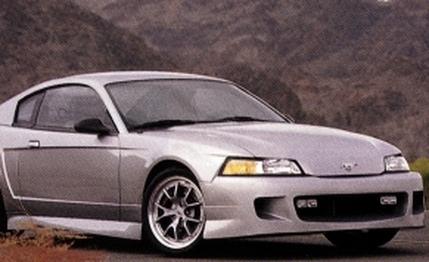 Road Test
Road Test
There's something vaguely awe inspiring about the Mustang you see here--apart from its 415-horsepower twin-;cam V-8, apart from its five-inch wheelbase extension, and apart from a hood that droops over its grille like a springer spaniel's tongue. That awe-inspiring thing is this: You can wander out to your garage on 40 or 400 consecutive spare evenings and assemble a Mustang absolutely identical to this one, right down to its carbon-fiber dog's tongue. No kidding. All you'll need is a donor SVT Cobra ($28,155), a complete set of Snap-ons ($250), a Ford Racing catalog ($5) from which to order a few parts (approximately $26,000 worth), and a family doctor trained to treat knuckles skinned in a pasttime likely to land you in divorce court (priceless).
When you're finished -- both in the garage and in front of Judge Mills Lane --you'll own a street-legal Mustang that accelerates to 60 mph in 4.5 seconds (same as your neighbor's Ferrari Modena 360), carries on to a top speed of 168 mph, and possesses stiction that exceeds your other neighbor's Corvette's. Course, that particular neighbor's Corvette will have cost a lot fewer dollars, and its owner will, you know, still be married to someone, whereas you will be sleeping in a tent at Milan dragway and wondering aloud whether you can swap a plaid sleeping bag for a fresh set of BFGs.
Last June, the idea for the Mustang FR500 found residence in the overactive brain of Dan Davis, the 50-year-old director of Ford Racing Technology. Whether you know it or not, you're familiar with this Dearborn division. It used to be called SVO (Special Vehicle Operations), but that acronym was so often confused with SVE (Special Vehicle Engineering), with SVT (Special Vehicle Team), and with B.V.D. (a brand of excellent underwear) that the guys in Dearborn jettisoned it (the name, not their excellent underwear).
So now it's simply Ford Racing, whose chief source of income derives from aftermarket performance parts. The FR500 ("FR" for Ford Racing and "500" for five liters of V-8 displacement) comprises more than 100 of those unique parts, each to be depicted in Ford Racing catalogs by midsummer.
"When I arrived here a year and a half ago," says Davis, "I saw that SVO had been making most of its money from the old 4.9-liter pushrod motor. I said: 'That's not the future. The future is the modular twin-cam, and the sooner we offer upgrades for it, the sooner we'll see profits.' What we needed was a showcase motor -- something making 400 horsepower without superchargers or turbos ;-- and it had to be emissions-legal."
To his credit, Davis further realized that a stand-alone engine, however enticing, had about the same effect on would-be buyers as Victoria's Secret lingerie draped atop wire-frame mannequins. The high-output V-8 thus became a car that became a parts program.
To build the FR500, Davis's engineers opted to perform the "intellectual work," and McLaren Engines in Detroit was tapped to undertake the fabrication and assembly. The goal was a Mustang that would "accelerate, handle, and stop as competently as a Corvette," says Davis. He then allotted the program what is, by Ford's standards, a peewee budget: $500,000, a sum sufficient for only two mules and a show car unveiled in Vegas, sans naked girls and marching bands.
Car and Driver was afforded access to the second of the mules, a homely specimen whose black-and-white body parts, haphazardly fitted, imbued it with a Broderick Crawford Highway Patrol countenance. That car's innards, however, proved fairly glorious.
The heart of the FR500's twin-cam V-8 is a new aluminum block with 94-millimeter bores, bumping displacement to 4997cc. Although you can keep your Cobra's stock crankshaft and rods, a "bottom-end kit" (which refers to no item offered by Victoria's Secret) includes fitted pistons thumping away at a surprisingly subdued 9.9:1 compression ratio. The trick Ford Racing cylinder heads, featuring more radical cams and larger ports and valves, are topped by a flashy magnesium intake manifold with two 70mm throttle bodies yanked from Ford's 5.4-liter truck engine. The intake's twin air inlets, which resemble the bass pipes from Ralph Reed's favorite church organ, require that the battery find residence in the trunk, a relocation to the betterment of weight distribution. Add to those underhood ministrations unique headers, an EEC-V computer, and a 36mm radiator core, and you wind up with 415 horsepower at 6800 rpm and 365 pound-feet of leverage at 4200 rpm. The only reliable way to transfer that much mechanical mayhem to the rear wheels is to funnel it first through a dual-disc Valeo clutch (same as a Ferrari F50's) and a six-speed Tremec T56 transmission (same as a Dodge Viper's).